Pulsed x-rays from synchrotrons are a valuable tool for testing and measurement in various industries or for novel therapies. Lasers could soon make them a feasible tool as well.
ANDREAS THOSS, CONTRIBUTING EDITOR
The laser is a versatile tool for many applications partly due to its capacity
to generate harmonic wavelengths in which, for example, two red photons
combine to generate a blue photon. But with the advent of ultrashort laser pulses, processes were discovered to generate many more wavelengths using extremely intense laser pulses. Often, these processes are based on highly nonlinear effects from plasma physics. After decades of development, such processes can be used not only to generate various secondary sources of electromagnetic radiation, but also beams of electrons or even protons.
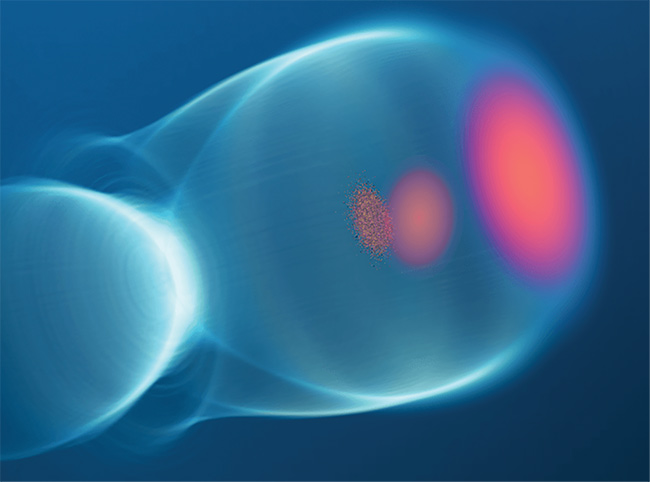
A laser pulse (red) fired into a plasma accelerates electrons (orange) in its wake (blue). A second laser pulse scatters off the electron bunch to produce x-rays. Courtesy of DESY, Ángel Ferran Pousa.
Such secondary sources are attracting
a great deal of commercial interest, prompting the development of laser-based systems designed to generate secondary radiation at wavelengths that would be difficult to achieve by other means.
One industrial secondary source already creates about $1 billion in revenue: It is the extreme-UV source from TRUMPF that is crucial for ASML’s most advanced semiconductor lithography systems and, lately, the subject of international trade conflicts.
Why secondary sources?
The main reason to further explore secondary sources is due to their potential to replace particle accelerators as sophisticated beam sources. Studying particle physics (namely positron-electron collisions) was the primary purpose of the storage ring PETRA II, later converted in 2010 to PETRA III, which is one of the accelerator-based facilities at Germany’s DESY electron synchrotron and research center.
After the facility’s major 2010 upgrade and relabeling as PETRA III, it was used entirely to generate hard x-rays. Until the recent upgrade to the European Synchrotron Radiation Facility (ESRF) in 2020, DESY had been the most brilliant source of its kind, with 25 beamlines supplying almost 60 measuring stations with valuable photons.
DESY’s facility is regularly overbooked and only a fraction of the requested experiments are granted. It is mainly used for academic research, but major car manufacturers as well as aerospace enterprises also use the PETRA III facility for specific research; materials sciences, life sciences, and environmental research are other fields investigated there.
The European Molecular Biology Laboratory even constructed an integrated research facility for structural biology at PETRA III.
Although most of its research uses synchrotron radiation for imaging, promising therapeutic options are also being explored. FLASH radiotherapy — unrelated to the FLASH facility at DESY — promises rapid progress in cancer therapy. Its key innovation is to apply radiation treatments in single, fast, intense doses rather than as sequences of low-intensity doses over time. Although mid-scale accelerator-based facilities can also deliver such precisely tuned irradiance, smaller installations are highly desirable at clinical sites.
Looking into the melt pool
The Fraunhofer Institute for Laser Technology (ILT) and TRUMPF recently presented research on potential industrial laser applications for synchrotron radiation, wherein they investigated the use of high-resolution x-rays to monitor laser processes such as copper welding. Specifically, they sent exceptional x-rays from the PETRA III instrument through the focusing optics of seven different laser sources. Fraunhofer ILT and TRUMPF performed several hundred experiments and recorded up to 20,000 images per second.
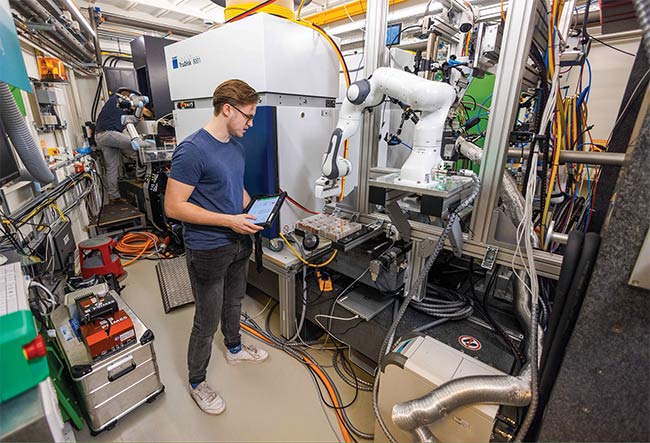
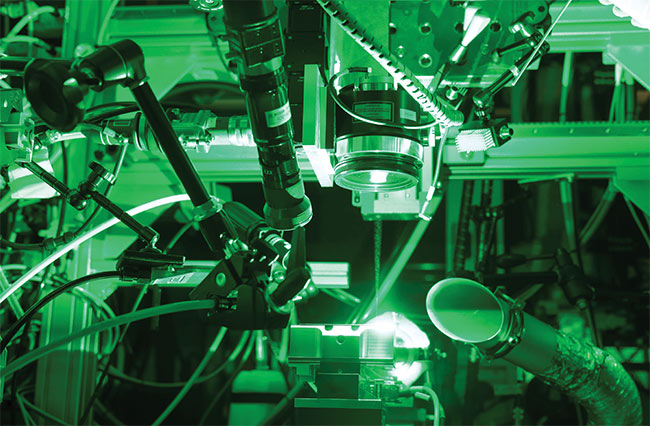
TRUMPF and Fraunhofer ILT leveraged the particle accelerator at the German Electron Synchrotron (DESY) in Hamburg to investigate laser welding of copper connections for e-mobility. Courtesy of TRUMPF.
“Conventional methods actually only see the electromagnetic emissions from the plasma,” said Marc Hummel, a scientist at Fraunhofer ILT. “With DESY’s radiation, we can not only look inside the melt, but we can even make the melt dynamics visible.”
“For us, this is a great opportunity to study welding processes on industrial parts,” said Mauritz Möller, automotive industry manager at TRUMPF. “For example, how do spatters and pores form, and how does the heat from the welding process affect sensitive components such as electronic parts?”
The PETRA III experiments deliver valuable process knowledge that will soon be used to produce millions of copper weld seams more efficiently. The Fraunhofer researchers have already scheduled their next trip to the DESY facility in Hamburg, Germany.
After gathering process knowledge for cutting, welding, and drilling processes, they plan to look more deeply into the use of secondary sources to examine the 3D-printing processes that form metal components.
A 6-GeV moonshot
Such developments indicate that a market for precision measurements and medical therapies based on precise high-energy x-rays is emerging and, thus, driving further interest in synchrotron sources.
Argonne National Laboratories, for example, recently announced its plans to launch an upgrade to its Advanced Photon Source next year. When it is complete, the Source’s x-ray beams will be up to 500× brighter, enabling research capabilities that will lead to longer-lasting, faster-charging batteries, more durable airplane engines, and better treatments for infectious diseases.
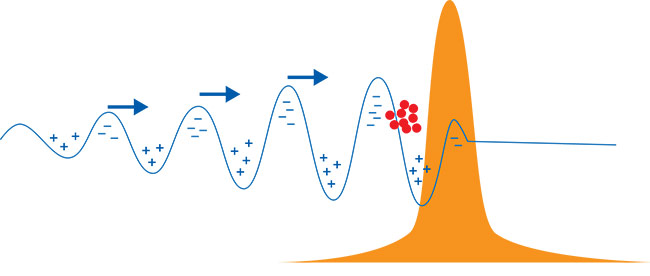
When a strong laser pulse (orange) passes through a gas, such as hydrogen, the optical energy ionizes the gas. Electrons (red) accumulate in the wake of the pulse and are accelerated by the positively charged plasma wave — similar to the wake of water that follows a ship. Courtesy of University of Hamburg.
Wim Leemans, director of the accelerator division at DESY, also has ambitious plans to upgrade the PETRA synchrotron, including the introduction of laser-based particle acceleration on a regular basis.
“The moonshot is we will build a plasma injector, a full-energy 6-GeV plasma injector to feed that big storage ring in what we call top-up mode,” Leemans said. “So, we [would] keep trickling in charge with a laser plasma accelerator.” This part of the proposal for PETRA IV is anticipated to begin construction in 2027. It is also part of a mission that Leemans adopted after moving to Hamburg from Berkeley, California, in 2019, where he had been director of the accelerator technologies and applied physics division at Lawrence Berkley National Laboratory and head of the Lab’s Laser Accelerator Center.
The idea of laser-based particle acceleration has been around for decades — why is it still such a “moonshot?” The challenges are certainly severe, but they also involve very different areas of expertise.
Laser plasma is produced when the energy from a laser effectively creates an explosion in which electrons of various energies fly in different directions. Until now, the laser systems for energetic plasma generation could deliver 10 shots per second at best. More often, they achieve one shot per hour. Synchrotrons, in contrast, are instruments that produce brilliant beams of monochromatic x-rays in continuous pulse trains in an around-the-clock schedule. The worlds that these two sources occupy are as distant as the Earth and moon, and so are the researchers that navigate them.
Laser-based electron acceleration
In this context, it is well worth having a short look at the fundamental physics behind laser acceleration.
Laser acceleration occurs when a strong laser pulse travels through plasma, which is a cloud of electrons and positive ions. The lightwave pushes the light electrons aside while dragging them on in its wake — hence laser wakefield acceleration. A strong laser pulse makes for a strong wave and drags more electrons into its wake. As it does so, it also accelerates the electrons to the speed of light within the plasma.
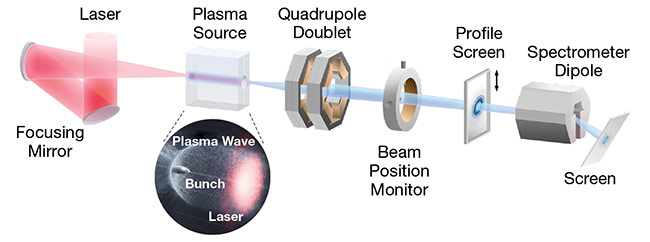
Scientists at DESY combine laser technology and typical synchrotron technology for the laser-based electron injector. Courtesy of DESY, Manuel Kirchen.
Although conventional, radio-frequency-based schemes can achieve
acceleration voltages between 10 and
40 MeV/m, a laser-based scheme supports between 10 and 100 GeV/m. Even if the actual plasma is only a few centimeters long, a short laser pulse still pushes electrons forward more quickly than a meter-long radio-frequency scheme. In a perfect world, such laser-based systems could reduce a kilometer-long synchrotron to the size of a tabletop.
Before this can become a reality, however, a few physics problems must be solved. First, there is the issue of gain, or plasma length, versus beam divergence: The longer the plasma channel is, the more energy the accelerated electrons will have. Unfortunately, this also increases the divergence of the laser beam. Therefore, thin discharge capillaries have been introduced to guide the laser light as if it were inside an optical fiber. With this approach, a research study in 2019 demonstrated 8 GeV electrons from a 20-cm capillary using a laser with 1-PW peak power for the acceleration1.
Another challenge is the energy spread or the dephasing of laser pulses and
electron bunches. The denser the plasma, the stronger this problem becomes.
Researchers at DESY recently developed a prepulse concept that allows a much smaller energy spread. With a fed-in
electron bunch accelerated at a gradient of 1.3 GV/m, the researchers achieved an energy spread of 0.1%2.
Maintaining long-term stability of pulse energy, pulse profile, and other beam features presents yet another challenge. Such stability is important as synchrotrons operate with nearly 99% uptime. DESY’s highly stable beam also allowed scientists to correlate its instrument’s drive laser and electron-beam parameters with high statistics to identify and quantify sources of electron energy drift and jitter. This enabled them to achieve the first stable 24-hour operation of a laser plasma accelerator3 in 2020.
Lastly, there is the challenge of maximizing repetition rate. Again, PETRA III delivers continuous trains of pulses around the clock. The revolution frequency of the electron bunches is 130 kHz, and these bunches can be created with different counts and lengths. The typical separations between bunches are 8 ns, 16 ns, and 192 ns. The most advanced petawatt laser in the world is the High-Repetition-Rate Advanced Petawatt Laser System (HAPLS) at the ELI-BL institute in Dolní Brežany, Czech Republic. It is designed to deliver repetition rates up to 10 Hz, but typically runs at 3 Hz.
Obviously, researchers require sources with high peak powers and repetition rates to succeed in laser particle acceleration, and Leemans and his colleague Andreas Maier, lead scientist at DESY, aim to achieve this with the KALDERA laser in Hamburg.
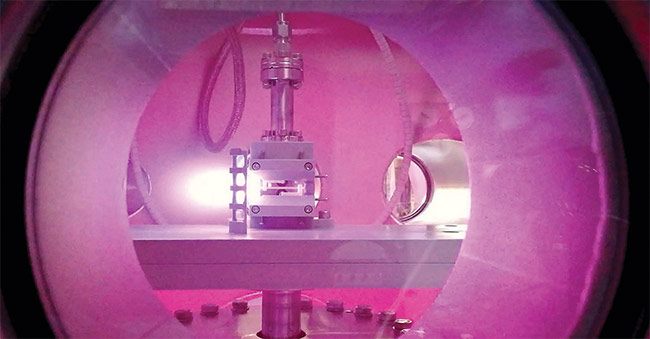
View into a vacuum chamber with a centimeter-scale source of giga-electronvolt beams. The plasma is generated in the narrow channel in the center by a high voltage. Courtesy of DESY, Alexander Knetsch.
“It will be a 100-TW kilohertz repetition rate laser,” Leemans said. “Three joules in 30 femtoseconds at a kilohertz. First, light will be at 100 Hz, and we expect that toward the end of this year, certainly next year. And then, we rapidly want to boost it up to the kilohertz level with sufficient power to produce an electron beam with an energy of 1 GeV.”
If this yields the anticipated result, KALDERA will be — for a while — the strongest (by 3 kW average power) terawatt-class laser in the world.
Another ten years
So, is everything all set to go for KALDERA? Not exactly. But when it begins operation, so will new avenues for research. This laser will allow researchers to work with feedback loops — a familiar tool for accelerator scientists, but a huge step forward for laser plasma research. With this feedback, they can begin more coupling experiments to explore the challenges when feeding laser-accelerated electrons into a radio-frequency-based accelerator. These challenges include maintaining stability of the electron energy, ensuring correct triggering, and quantifying jitter.
Staging, the combination of several laser accelerator stages, is the next step. Research into staging is still in its infancy, but it carries the potential to feed electrons from previous acceleration operations into a laser-based stage to achieve higher electron energies.
Still, the development of laser-based acceleration schemes is worth the effort. Leemans asked his design team what a laser-based feeder would mean for PETRA IV. “They came back to me and said, ‘Even conservatively, it’s a factor of 10 reduction in power consumption.’”
Maybe the biggest problem is the cost and complexity of this laser technology. “We need to get the price down by at least an order of magnitude,” said Leemans. The cost for HAPLS — built in his old neighborhood near Lawrence Livermore National Laboratory (LLNL) — was
$45 million. Given an estimated number of 50 petawatt lasers in the world, one can easily imagine how the progress in Hamburg might spark a new wave of high average power terawatt or petawatt systems.
Constantin Haefner, who led the team that built HAPLS at LLNL, is now director of the Fraunhofer ILT in Aachen, Germany. The diode-pumped solid-state HAPLS marks a new era in secondary source drivers that boasts unparalleled precision and power due to fusion laser technology, Haefner said. “With [inertial fusion energy] on the horizon, the market can expect scalable growth and cost-effective innovations in laser technology, ultimately unleashing the full potential of compact, high-brightness secondary sources.”
In fact, Torsten Mans, product manager of secondary sources at TRUMPF, presented some promising lasers for secondary sources at the recent UKP-Workshop in Aachen. All have a repetition rate of
1 kHz or more and a maximum peak power of 4 TW. Several applications could drive demand. Laser-based nuclear fusion will significantly depend on such sources, as will next-generation particle research schemes because they cannot feasibly get larger. Under the Helmholtz Society — the organization that governs DESY and other large research facilities in Germany — DESY has started HI-ACTS, which is a platform to convert its offerings for industry customers. The aim is to develop use cases for emerging technologies.
Once the technology is developed for smaller tabletop synchrotron systems, such secondary sources could change the game for several end markets by bringing compact x-ray sources to the application, be it a medical center or an industrial site. A local source of brilliant x-rays would open a path into the rapid understanding of laser processes, for example. Laser processing gets ever more sophisticated, and that tool would help to make sophisticated processes available to many more customers.
References
1. A.J. Gonsalves et al. (2019). Petawatt laser guiding and electron beam acceleration to 8 GeV in a laser-heated capillary discharge waveguide. Phys Rev Lett, Vol. 122,
p. 084801.
2. C.A. Lindstrøm et al. (2021). Energy-spread preservation and high efficiency in a plasma-wakefield accelerator. Phys Rev Lett, Vol. 126, p. 014801.
3. Andreas R. Maier et al. (2020). Decoding sources of energy variability in a laser-
plasma accelerator. Phys Rev X, Vol. 10,
p. 031039.